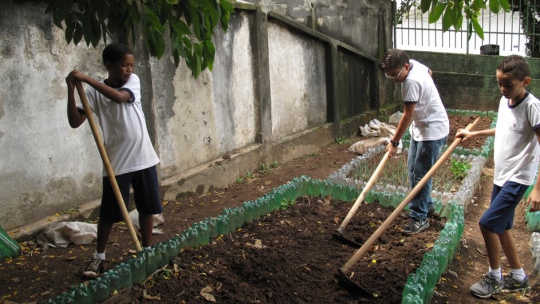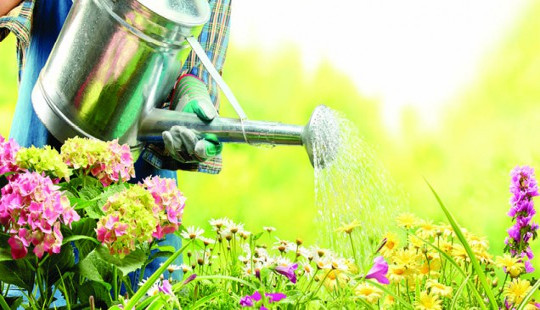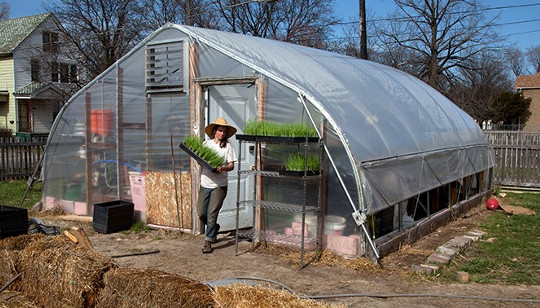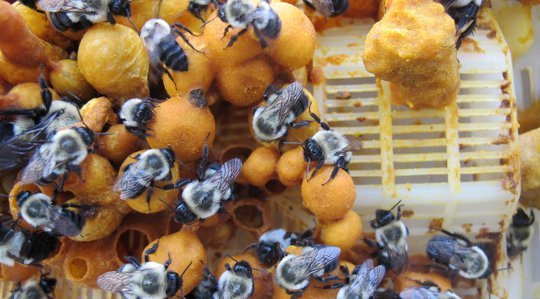 Urban flooding represents the most common yet severe environmental threat to cities and towns worldwide. Future changes in rainfall extremes are likely to increase this threat, even in areas that could become drier.
Urban flooding represents the most common yet severe environmental threat to cities and towns worldwide. Future changes in rainfall extremes are likely to increase this threat, even in areas that could become drier.
 With more people than ever living in cities, how do we reconcile our need for fresh fruit and vegetables with the challenges of life in an urban environment where the time and space for gardening are limited?
With more people than ever living in cities, how do we reconcile our need for fresh fruit and vegetables with the challenges of life in an urban environment where the time and space for gardening are limited?

Some farmers have turned to less chemically-intensive techniques to reduce the negative impact of agriculture, such as organic farming, which has been shown to outperform conventional farming by many standards of environmental sustainability. The question is whether we can meet the demand for food, which is predicted to rise substantially in the next 50 years.

On a hilly slope in São Paulo City, a group of sixth graders is busy at work. They’re armed with seeds, soil and a range of gardening tools. Upside-down soda bottles, filled with water, outline a series of rectangular garden plots.
 The environmental and nutrient impact of our food choices had been on my mind for several weeks when a year-old article in the Telegraph recently came to my attention, prompting me to assemble the thoughts that had been gradually coalescing.
The environmental and nutrient impact of our food choices had been on my mind for several weeks when a year-old article in the Telegraph recently came to my attention, prompting me to assemble the thoughts that had been gradually coalescing.
 More than half the planet’s population now live in cities, with limited access to the natural world. For Europe and Latin America, the figure is more than 70%. Yet contact with nature has numerous benefits for both our physical and mental health.
More than half the planet’s population now live in cities, with limited access to the natural world. For Europe and Latin America, the figure is more than 70%. Yet contact with nature has numerous benefits for both our physical and mental health.
 Concerns about environmental damage caused by costly chemicals and worries about climate change are altering farming methods in the mountains of Nepal.
Concerns about environmental damage caused by costly chemicals and worries about climate change are altering farming methods in the mountains of Nepal.
 Life, for foragers, can be more secure for the simple fact that they understand crop failures happen. Thus, we learn not to depend wholly on one type of food. The lovely thing about foraging is that there are always alternatives. In nature, there are usually plenty of options, and all of them are free.
Life, for foragers, can be more secure for the simple fact that they understand crop failures happen. Thus, we learn not to depend wholly on one type of food. The lovely thing about foraging is that there are always alternatives. In nature, there are usually plenty of options, and all of them are free.
 Most people have never heard of Norman Borlaug. He is, thus far, the only agricultural scientist ever to win the Nobel Peace Prize. His work in the development of high-yielding and disease-resistant cereal crops saved more than one billion (yes, billion) people from starvation.
Most people have never heard of Norman Borlaug. He is, thus far, the only agricultural scientist ever to win the Nobel Peace Prize. His work in the development of high-yielding and disease-resistant cereal crops saved more than one billion (yes, billion) people from starvation.
 The key to gardening is dirt. If you can grow good dirt now, you can grow good vegetables this spring. And you don’t have to run to the garden store to load up on boxes and bags of stuff to do it if you start early and think of it as a year-round project.
The key to gardening is dirt. If you can grow good dirt now, you can grow good vegetables this spring. And you don’t have to run to the garden store to load up on boxes and bags of stuff to do it if you start early and think of it as a year-round project.
 The key characteristic of the loving landscape is healthy, living soils which foster plant and animal health without artificial inputs. Compost, mulch and worms form the holy trinity of organic soil health.
The key characteristic of the loving landscape is healthy, living soils which foster plant and animal health without artificial inputs. Compost, mulch and worms form the holy trinity of organic soil health.
 Drought-stricken regions such as California are trying to restrict water use by residents, and that puts a target on the lawn. But Americans are wedded to the green, even if some resort to artificial lawns and other water-saving alternatives.
Drought-stricken regions such as California are trying to restrict water use by residents, and that puts a target on the lawn. But Americans are wedded to the green, even if some resort to artificial lawns and other water-saving alternatives.
 Midway through spring, the nearly bare planting beds of Carolyn Leadley’s Rising Pheasant Farms, in the Poletown neighborhood of Detroit, barely foreshadow the cornucopian abundance to come. It will be many months before Leadley is selling produce from this one-fifth-acre plot.
Midway through spring, the nearly bare planting beds of Carolyn Leadley’s Rising Pheasant Farms, in the Poletown neighborhood of Detroit, barely foreshadow the cornucopian abundance to come. It will be many months before Leadley is selling produce from this one-fifth-acre plot.
 Both compost and mulch foster the life of the soil, and both are important components of the loving landscape. Sometimes they are confused for one another, but they are quite different animals. Compost, which we talked about last week, is more nutrient rich than mulch. It’s full of life, and inoculates soil with that life.
Both compost and mulch foster the life of the soil, and both are important components of the loving landscape. Sometimes they are confused for one another, but they are quite different animals. Compost, which we talked about last week, is more nutrient rich than mulch. It’s full of life, and inoculates soil with that life.
 So, let’s say we want to play nice with the rest of nature. Let’s say we want public parks, yards and gardens which exist for more than show, spaces which support a diversity of life, steward our resources wisely and are a joy to the eye. We’ve got to change the existing lifeless paradigm of lawn and hedge and disposable annual flowers.
So, let’s say we want to play nice with the rest of nature. Let’s say we want public parks, yards and gardens which exist for more than show, spaces which support a diversity of life, steward our resources wisely and are a joy to the eye. We’ve got to change the existing lifeless paradigm of lawn and hedge and disposable annual flowers.
- By Bryan Welch
 The Posey homestead probably wouldn't strike most Americans as a vision of paradise. We lived on dunes dotted with creosote and mesquite bushes, cactus and yucca. Mostly, the land was bare sand. We had seven or eight inches of total precipitation a year...
The Posey homestead probably wouldn't strike most Americans as a vision of paradise. We lived on dunes dotted with creosote and mesquite bushes, cactus and yucca. Mostly, the land was bare sand. We had seven or eight inches of total precipitation a year...

You don't need a garden to grow mushrooms—any cool, shady space will do, even a cupboard or dark corner. It’s fairly easy to grow oyster mushrooms indoors in a bag or a 2-gallon bucket using sawdust or spent coffee grounds as the growing medium.
- By R Jennings

While urban farming is not a new concept, it is making a modern comeback. The benefits of urban farming well surpass the nutrition aspect, though of course, that is a major part of it.
 When foraging, as with gardening, it is important to know what is available where one lives. The best way to forage is to simply get outside, slow down and walk around, listening and looking. This is really the only way to get to know an area, but when driving anywhere, we will...
When foraging, as with gardening, it is important to know what is available where one lives. The best way to forage is to simply get outside, slow down and walk around, listening and looking. This is really the only way to get to know an area, but when driving anywhere, we will...
- By Pam Dawling

Growers wishing to produce crops over as long a season as possible use various methods to extend the survival of frost-tender crops beyond the first fall frosts, keep semi-hardy crops alive through the winter, and boost winter production of hardy crops...

Have you ever tried to grow your favorite summer vegetable or garden herb and something went wrong? Maybe it was poor planting, a disease, or a pesky insect. Maybe you need to troubleshoot problems or want definitive answers to questions like when to plant for your area or exactly when to fertilize.

For years, many of us have kept an eye out for organic and pesticide free vendors at our local farmers markets. Thanks to a new movement hitting the American food scene, we may soon be looking for another important environmental marker: open source seeds. At least, that is the goal of...
















